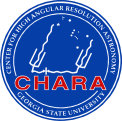Overview
The following paper provides a general introduction to image reconstruction for interferometric data. The authors discuss the effects of different regularization schemes and provide a comprehensive review of existing algorithms.
Principles of image reconstruction in optical interferometry: tutorial. Thiébaut, É. and Young, J. J. Opt Soc. Am. A, 34, 904 (2017)
SQUEEZE - Image reconstruction software
SQUEEZE is an image reconstruction software package for optical interferometry developed by Fabien Baron of Georgia State University and distributed under an open source (GPL v3) license. It is designed to image complex astrophysical sources, while (optionally) modeling them simultaneously with analytic model (e.g. "SPARCO" mode). SQUEEZE can do polychromatic imaging provided the number of binned spectral channels remains low. SQUEEZE is based on Markov Chain Monte-Carlo (MCMC) exploration of the imaging probability space, and reconstructs images and associated error bars from standard OIFITS data. SQUEEZE leverages the Open Multi-Processing (OpenMP) application programming interface to implement simulated annealing and parallel tempering, in the hope of avoiding the local minima better than classic gradient-based image reconstruction software.
OITOOLS - All purpose optical interferometry software
OITOOLS is an environment tools to load, simulate, visualize, model-fit and image optical interferometry data coming from CHARA, NPOI and VLTI, written in Julia by GSU Professor Fabien Baron. OITOOLS allows polychromatic and polytemporal imaging thanks to the powerful OptimPackNextGen library written by Eric Thiebaut.
Download OITOOLS.
ROTIR - Surface Imaging of Rotating Stars
ROTIR allows surface imaging of rotating stars. The necessary physics is included to image rapid rotators or Roche surfaces. A binary module is in the works to allow imaging of evolving systems.
Download ROTIR.
MIRA
The Multi-aperture Image Reconstruction Algorithm (MIRA) is an algorithm for image reconstruction from interferometric data. The software is written in Yorick. MiRA proceeds by direct minimization of a penalized likelihood. This penalty is the sum of two terms: a likelihood term which enforces agreement of the model with the data, plus a regularization term to account for priors. The priors are required to lever the many degeneracies due to the sparseness of the spatial frequency sampling. MiRA implements many different regularizations (quadratic or edge-preserving smoothness, total variation, maximum entropy, etc.) and lets the user defines their own priors. The likelihood penalty is modular and designed to account for available data of any kind (complex visibilities, powerspectra and/or closure phase). One of the strengths of MiRA is that it is purely based on an inverse problem approach and can therefore cope with incomplete data sets; for instance, MiRA can build an image without any Fourier phase information.



